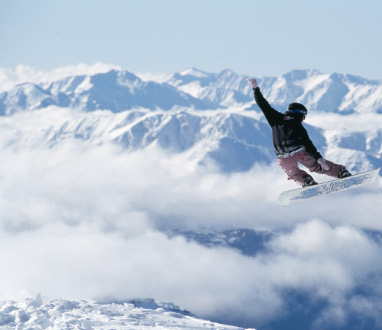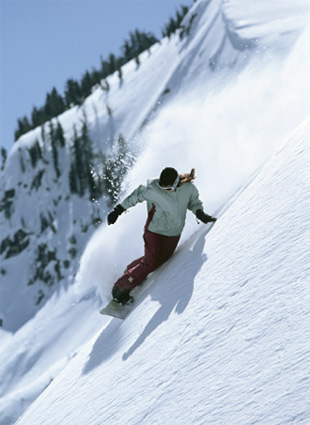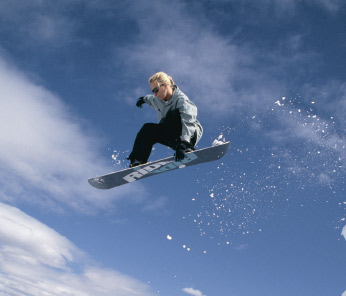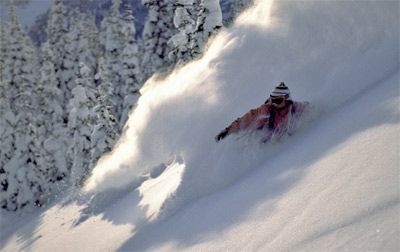Words by: Chris Moran
In 1993, the Australian lager company Castlemaine XXXX ran a campaign on British television in which two Aussie men stood around watching their pick-up truck being
loaded with crates of beer. As an afterthought, they ask the shopkeeper for two bottles of sherry “for the ladies”. The axle on their truck buckles under the weight of the added bottles, and the owner turns to his friend and says “looks like we overdid it with the sherry”. It was a popular and funny ad, which worked because everyone knew it was ironic.
Around the same time, however, the worldwide snowboard industry seemed to have a similar attitude, but without the joke. The 1994 Air & Style comp, for example, featured a 60ft kicker, and although there were girls invited to ride at the contest, that particular jump was strictly out of bounds. To hammer it home a sign on the run-in even read ‘No Girls’.
Today of course, the situation is far better. There are girl-specific boards, lines of clothing, film producers making girl-only movies and magazines like the one in your hands. Such infrastructure means an elite of female snowboarding superstars is sustainable. Hannah Teter showed off her Olympic Gold medal on the David Letterman Show, our cover girl Torah Bright is perhaps one of the most famous sportspeople in Australia (though whether she’s a sherry drinker is unlikely) and the next generation of girls such as Jamie Anderson are increasingly riding for equal prize money, a feat not even the tennis world has achieved.
But all this is no happy accident. The gap has been closed due to the actions of many influential characters, each one chipping away at the stereotypes and adding vital strength to the girls’ scene. While a list of those riders would be exhaustive, standouts include Bonnie Zellers from the first TB series of films, Shannon Dunn, owner of the first pro model board, Michelle Taggart and her pipe riding skills, and those behind the scenes such as Amy Howat – instrumental in organising the Mt Baker Banked Slalom, still hailed today as the most fun snowboard competition in existence.
Without these riders and more, we may well still be stuck in the dark ages. But it is without doubt the following five girls that have made the most lasting impression on the world scene. After all, it was one of them that stood up to the ‘No Girls’ sign back at the Air & Style all those years ago. “I looked at the jump,” said Tina Basich in her autobiography Pretty Good for a Girl “…and then went and put on the Beastie Boys to get all amped up. There were like 100 stairs to the top of the jump. We walked half way up and stopped. Then I don’t remember walking the rest of the way up but I did not hesitate. I took three breaths and then dropped.”
Magazines reported that she “had gone bigger than the guys” and probably would have placed in the top ten. “I think the gap between men and women just makes women
work harder,” said Tina in 1999. “If we were right there, we might not take it to the next level. So we’re definitely pushing toward closing the gap, and we’re motivated.”
 Barrett Christy, USA
Barrett Christy, USA
Buffalo NY isn’t exactly a snowboard hotspot so in 1992, after a couple of winters learning to ride at Killington and Vermont, Barrett moved
to the emerging snowboard scene at Crested Butte, Colorado. It’s easy to see the attraction – Crested Butte was famed for its powder and nearby Vail had opened the world’s first snowboard park two seasons before, so the chance to ride with the best riders in the US, coupled with the bonus of getting some freshies, was too much to ignore. Christy liked to think of her style as being quite skateinspired, claiming the idea of keeping things flowing was her main goal. “Whether it’s linking turns in powder, riding technical lines, jumping, sliding or whatever, it’s that quest to get the feeling as often as possible,” she said at the time. But while she was riding for her own satisfaction, she was hitting the park enough to start entering comps and impressing her peers. “Barrett is little,” said Vail’s Todd Richards, “but she carries a big stick.”
In between impressing the seasonaires at Butte and Vail with her cliff lines, Barrett saw the freestyle opportunity and pushed herself to ride hard. It was a gamble that paid off. After winning an amateur pipe contest in Vail, she went on to be the most successful freestyle snowboarder the US has ever produced, with a medal placing at every single X Games up until 2003. But while she was big time at the comps, she could also hold her own in the backcountry. “I need to balance out contests,”
she said in 2001. “If I don’t have time to just snowboard for myself, it gets a little gruelling.”
After having a pro model on Gnu snowboards, Barrett finally moved out of the pro scene in 2004. Now 35, she spends her time riding at Mt Baker and Vail, or working out of Portland, Oregon. Today she coaches and manages the Nike 6.0 snowboard team in the US, is married to fellow Gnu pro rider Temple Cummins and is hugely thankful for her time as a pro rider.
Reflecting on the growth of women’s snowboarding she says, “The winter X Games didn’t exist until 97, and that seems like a pivotal time in snowboarding. They brought snowboarders to people’s living rooms and made some riders household names overnight. As a pro there weren’t the pressures that go along with the big paychecks today. Now, riders are expected to perform at all these events and often still film for a movie segment and get photos for sponsors and editorial.” She also notes how much better women-specific kit is these days. “The biggest obstacle I faced in the early 90s was getting equipment that was right for me,” she says. “I was always riding boards that were too big, too wide and too stiff.”
 Tina Basich, USA
Tina Basich, USA
Tina’s first day riding came in 1986 when she hiked the slopes of Soda Springs, Lake Tahoe, in a pair of moonboots with her brother Mike in tow. After learning to ride properly and placing well in some local and national contests, Tina turned pro in 1989 with a $250 a month deal with Kemper Snowboards. Riding with fellow pros Andy Hetzel and Matt Goodwill pushed her hard. “It was all I could do to keep up,” she said in an interview for The Way of the Snowboarder. “I even started to jump cliffs because I had to get the girl shot for the team.”
It was an attitude that served her well, and Tina became the dominant female pro. She also had one eye on the longevity of the girls’ scene, and along with fellow pro Shannon Dunn, launched Prom Clothing in 1995. “We wanted to start a girls’ line because at the time boys’ clothes were super-huge. So we called it Prom and wore prom dresses in the ads and made it all pastel colours.” Although the feeling had been that Tina and Shannon were trying to “make fun of the whole girl thing to get noticed as something different,” said Tina, the fact that the industry took it at face value and didn’t get the irony meant that Tina was unwilling to continue with the brand. Around the same time, her friend Monica Steward – one of the co-founders of Bonfire clothing – was diagnosed with breast cancer. Along with Shannon Dunn and Michelle Taggart, Tina organised a charity event and the foundations for Boarding for Breast Cancer were in place. Monica died at the tragically young age of 29.
Where she is nowBoarding for Breast Cancer has gone on to raise over $1 million, while Tina is universally hailed as one of the most influential women riders ever. Her autobiography Pretty Good for a Girl has sold incredibly well, she is a regular on the US chat show circuit and still rides regularly. She lives near Squaw Valley, Lake Tahoe, is a keen artist, and presents GKA (Girls Kick Ass) on Fuel TV in the US. She still says her favourite, favourite thing to do is to picnic in the backcountry with friends. “No hustle, no noise, no tracks, just fresh turns.”
Looking back on her career she says, “I think being a female athlete was part of the challenge but also part of the drive to push harder, get recognized for your skills and make your mark.” On snowboarding’s stratospheric rise she says, “It’s amazing how fast it grew. I think that it gives you such a feeling of freedom that it’s easy to get hooked on, and that’s what the world did, they got hooked on snowboarding.”
Amen to that.
Coming up: Nicole Angelrath, Circe Wallace and Victoria Jealouse… Nicole Angelrath, Switzerland
Nicole Angelrath, Switzerland
Nicole Angelrath and Arlette Javet were two Swiss riders who enjoyed travelling around Europe and checking out the emerging snowboard scene of 1989. At the Kebra Classic, Nicole impressed the French, but it wasn’t until Burton pro Jason Ford met and rode with Nicole that her career really took off. He suggested she should come to the States to enter some comps, reckoning her riding to be of a higher standard than her US counterparts. In 1993, Nicole took his advice, landed at the US Open and became the first European to win the World Championships. Along with Norway’s Terje Haakonsen, Nicole was the figurehead of European riding, forging a path that future generations of Euro riders – and especially Finnish girls Satu Jarvella and Mina Hessu – would later follow. Nicole was also blessed with natural good looks, and at a time when snowboarding was quickly becoming the darling of the fashion world, it was only natural that this blonde-haired, athletic girl from Switzerland would take a leading role.
Although such antics would be hardly newsworthy today, when Nicole stared in The Face magazine’s fashion overview of 1993, it was a landmark not just for girls’ riding, but for snowboarding as a whole. Nicole went on to win another world title, and started a great rivalry with US counterpart Michelle Taggart. Although they were fairly matched when it
came to tricks, it was widely acknowledged that Nicole’s style gave her the edge.
Nicole worked for Swissmate, a PR company based out of Lausanne before moving to the States with her husband, pro snowboarder Wille Yli-Luoma, and their daughter Lilou Isa Pirkko Angelrath Yli-Luoma.
 Circe Wallace, USA
Circe Wallace, USA
Circe (pronounced Ser-see) started riding in the late 80s after heading up to the burgeoning scene in Mt Baker from her home in Seattle, Washington. Craig Kelly, Mike Ranquet and a crew of riders named the Mt Baker Hardcore (in reality some of the most pleasant and professional riders to have formed a ‘team’) recognized her talent, and she rode with perhaps the cream of US freeriders in her formative years. The experience paid dividends and Circe soon found herself winning freestyle contests, and filming with Standard Films. “My best ever part was in TB6,” said Wallace in a recent interview with Transworld Snowboarding, but sections in Road Kill, TB2, Upping the Ante and Project 6 enabled her to pull in a wealth of sponsors. Ride Snowboards gave her a pro model, and she was involved in setting up women-specific clothing lines with both Vans, who gave her a pro model boot, and Roxy, with whom she was the first ever snow athlete. It was a lucrative time. “Money was OK,” she said recently, “I probably made more than a hundred grand a
year at the end.”
That end came when filming for TB6 had finished. “That was my grand finale,” says Circe. A knee injury meant she was unable to ride for the season, and one of her sponsors reneged on her contract and decided to drop her. She sought advice and found a lawyer to take up her case. “From that experience, I understood there was this huge need for someone to help people like me make good, wise decisions,” she said at the time. An obvious move was into athlete management.
Where she is nowCirce took her experiences as a pro rider in the more mercurial days of the mid-90s and formed up solid contracts for her stable of athletes. She became partner at the Familie, a Californian athlete management in 2000, broke away and formed her own IMS Sports Management soon after, and was recently bought by the global sports management agency Octagon. Under the Octagon umbrella she now looks after surfer Megan Abudo and snowboarders Travis Rice, Janna Meyen and Hana Beaman. “I can say to someone like Travis
Rice, ‘Enjoy this while it lasts and love every minute.’ I think he appreciates that because he knows I really get it.” Circe married former pro rider Andy Hetzel and the couple live in Washington with their daughter where they ride as much as they can.
Circe believes snowboarding’s vibe of pop culture versus anti establishment resulted in the billion dollar business it is today. And the toughest part for her was going out with a pro rider. She says, “The biggest obstacle I faced was trying to get noticed and sponsored while Jamie Lynn was my boyfriend. He was so incredibly good it didn’t matter how good I was. I was good and keeping up, but virtually invisible. It was the demise of our relationship.”
 Victoria Jealouse, Canada
Victoria Jealouse, Canada
Victoria’s life changed forever when she was invited on a Burton shoot in 1993. Prepared to ride all terrain, be it parks or pipe, Victoria found herself shooting in the backcountry. “One photo of me doing a powder turn at the shoot got me more attention from the industry than winning races ever did,” she says. “One photo changed everything.”
Victoria was subsequently offered a chance to ride in Alaska for Standard Films’ Totally Board 2, and has been part of the Alaskan riding community ever since. “It’s really hard always filming with only the best guys,” said Jealouse in the book Stoked: A Cultural History of Snowboarding. “I’m totally pushing myself.” Such commitment paid off. Victoria became the backcountry ‘face’ of Burton snowboards, the first female rider to get a Transworld Snowboarding cover, found a huge following in both the skiing and snowboarding worlds with her first descents, and gained a truck-load of admirers. “With the help of a girl-next-door hotness,” wrote ski mag Powder, “…she has gained a crossover appeal few in the snowsports industry have been able to pull off.” Lib Tech snowboards made a board featuring her riding on the base graphics – quite an accolade considering she has never
been sponsored by the company – and she continued to push the envelope in terms of backcountry skills. “If there’s no powder I’ll definitely ride park,” she said in a recent interview, “but most of the time, I’m in the big mountain situation.”
Today Victoria lives in Whistler and is still the most prominent female backcountry rider out there. She has the Sensation pro board with Burton, and has recently filmed groundbreaking parts in Absinth Films’ Saturation, as well as Teton Gravity Research’s High Life. Her back-catalogue includes most of the TB series, and her philosophy has remained true to her first trip to Alaska. “I usually think, ‘Am I making snowboarding look fun for women and am I making them see that they can do this stuff too?’ I don’t really think about what guys do.”
Of the main difference between snowboarding then and now, she says that “there are sooo many good kids now. There’s also things like snowboard schools and snowboard parents pushing their offspring like greyhound dogs (in the States anyway). Kids used to get punished for trading their skis in for snowboards. Now everyone wants to get a piece.”
The biggest obstacle Victoria has faced is being the only girl in an all-guy arena, as in backcountry filming. She says, “I’ve had a lot of support, but at the same time, there are things about being the only girl in a competitive environment of men that no one can really understand unless you are a girl and you’ve been in it. It’s just tricky to maintain your confidence and balance the social environment around you in those circumstances.”

